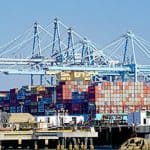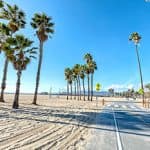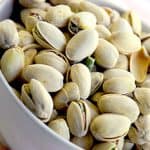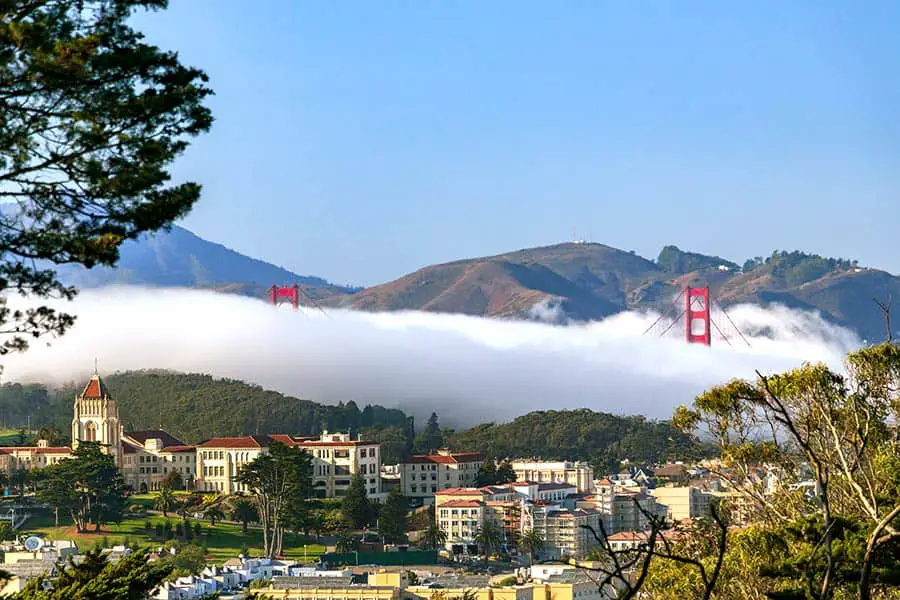
San Francisco is a gorgeous city that is often ensconced in fog. So persistent and pervasive is the fog that the locals have even given it a friendly nickname – Karl. But why is it that Karl has chosen to make San Francisco its home? Why is San Francisco so foggy?
San Francisco’s fog is a meteorological phenomenon. Hot air rises away from the city, and the rising air mass creates a low-pressure zone. This zone sucks in cold, moist air from the Pacific Ocean, which brings moisture into the local climate. As the air cools below the dew point, Karl condenses.
So that’s a basic explanation of the San Francisco fog, but there is so much more to discuss. How do the changing seasons affect the fog? Is the fog just a marine layer, and what even is a marine layer? Read on for some un-fog-gettable facts.
San Francisco’s Fog: Lifting the Veil
Let’s talk about fog. Fog is essentially a cloud that is close to the ground instead of in the sky. Like clouds, fog forms when the ambient air temperature drops below the dew point, at which time water vapor condenses out of the air. When this happens in the particulate-laden city air, that condensation becomes the infamous local fog.
Some may find this scientific lingo offputting. Think of it this way: temperature is a “bucket” that carries moisture. The warmer an air mass gets, the bigger the moisture bucket gets, and vice-versa. When the Pacific air blows in and the local air temperature drops, the moisture bucket shrinks, and the fog condenses.
San Francisco’s fog comes from a particular local meteorological phenomenon. In warm weather, inland temperatures along the California coast are quite warm. This heat creates a rising air mass and a temperature and pressure gradient that acts to suck in the marine layer that sits along the coastline.
The marine layer is an air mass, but it acts like a fluid. Fluids are lazy and like to flow through the point of least resistance. In San Francisco, this point happens to be the Golden Gate.
The city of San Francisco, and much of the Bay Area, sit inland from the Golden Gate. This confluence of things – the marine layer, the temperature and pressure gradient, the local geography – predisposes the region to fog. The fog is so integral to the area that much of the local ecosystem relies on the fog.
What is a Marine Layer?
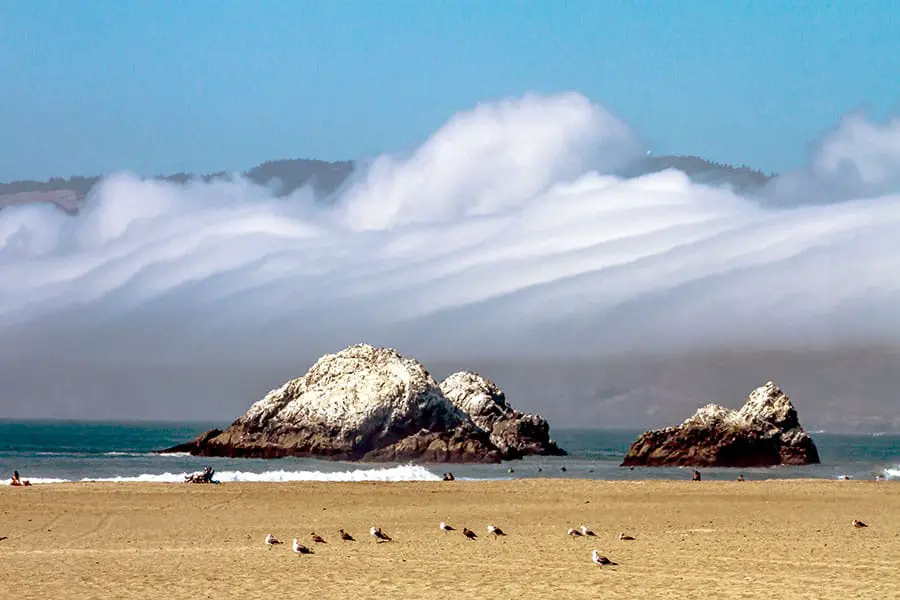
A marine layer is a mass of air that develops over large bodies of water when there is a temperature inversion. A temperature inversion is when the normal thermal lapse rate becomes inverted. That’s very sciency – let’s explain in plain words.
Typically, the air cools down as it rises. The rate at which air cools as it rises is called the lapse rate. In a temperature inversion, the air gets warmer as it rises: a warm air mass is sitting on top of a cool air mass. This mass blocks the rising of the cool air mass and creates a ‘lid’ effect that traps clouds, fog, smoke, and smog.
As the surface of the ocean cools the air mass above it, that air mass becomes cooler than the air above it and forms a temperature inversion. In effect, the marine layer is a dense, cool air mass found above a large body of water.
Does San Francisco Have a Marine Layer?
Yes. The coastline of the San Francisco Bay is a perfect place for the formation of marine layers. The same can be said for most of the California coastline. While San Fran is unique for her persistent fog, the marine layer exists over most coastal California.
Is the Marine Layer Just a Kind of Fog?
Strictly speaking, no. The marine layer is a dense, cool air mass. Fog is the condensation of water molecules out of an air mass as the temperature drops below the dew point. These conditions exist independently of one another.
There can be a marine layer without any clouds, fog, or other atmospheric phenomena. Be that as it may, the local conditions cause there to be fog more often than not – a robust marine layer is good for fog.
What Type of Fog Occurs in San Francisco?
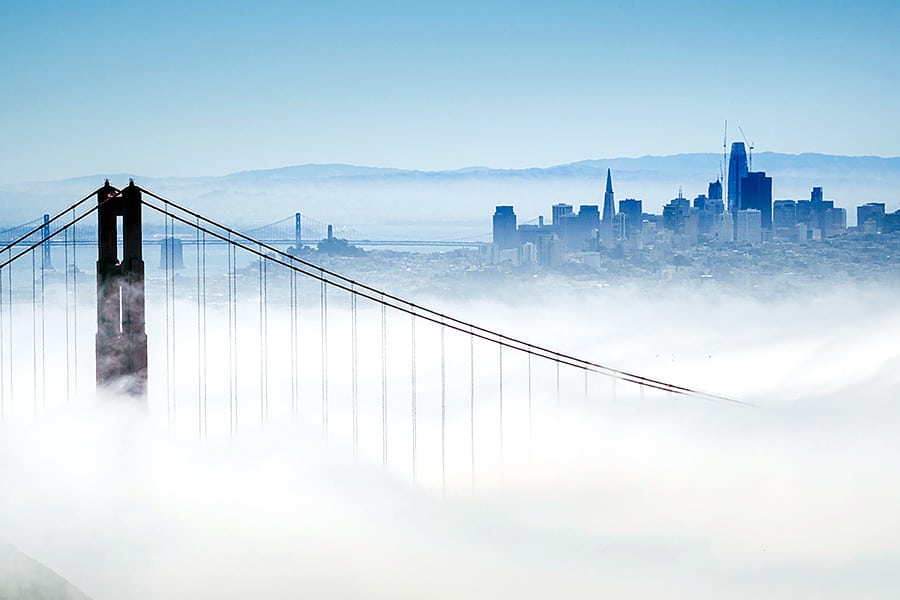
San Francisco has a kind of fog known as advection fog. This kind of fog forms when a warm, moist air mass moves over a cooler surface. In San Francisco’s case, the moist air masses form off the coast, and the cooler surface is the Pacific ocean.
Other Posts of Interest
- What Is Winter Like In San Francisco?
- What Is Alcatraz Used For Now?
- Is San Francisco An Island Or A Peninsula?
- Is The San Francisco Bay Bridge The Same As The Golden Gate Bridge?
Bay Area Answers Fun Fact: The foggiest place on earth is the Grand Banks, off the coast of Newfoundland. This area is notoriously foggy because of two currents that meet here: the frigid Labrador Current and the warm Gulf Stream. These tides converge at the Grand Banks and generate a lot of fog. The mixing currents also churn up nutrients, making this foggy sea a rich fishery.
Is San Francisco Foggy All Year?
No. While the fog is a frequent visitor to San Francisco, the Golden City averages 160 clear days a year. For reference, the city of Tampa, Florida clocks an average of 101 clear days per year. The San Francisco fog is definitely a regular sight, but locals get their share of pleasant days, too.
So how many days a year is San Francisco actually foggy? We know San Francisco enjoys about 160 clear days. Does that mean that the remaining 205 days of the year are foggy? No. The City by the Bay can expect to experience fog about 108 days a year. If the fog was evenly distributed throughout the year, you’d end up with fog about every three and a half days.
What Season is the Foggiest in San Francisco?
Summertime is the foggiest season in San Francisco. Remember, the fog is driven in part by high-temperature inland air. That warm summer air is the fuel that drives the coastal fog’s engine. The fog can be so intense that summer temperatures in the Golden City are often in the 60’s.
If you wish to avoid the fog, winter may be the best time to visit. Don’t fret if you’re not a fan of the deep freeze because the local San Fran climate likes to linger between 50 and 60 degrees, even in the winter.
What is the Foggiest Month in San Francisco?
The warmer summer months of June through August are the foggiest time in San Francisco. However, the foggiest overall month is probably June. Golden City locals sometimes refer to a “June gloom,” referring to the damp, cool, fog-laden days of early summer.
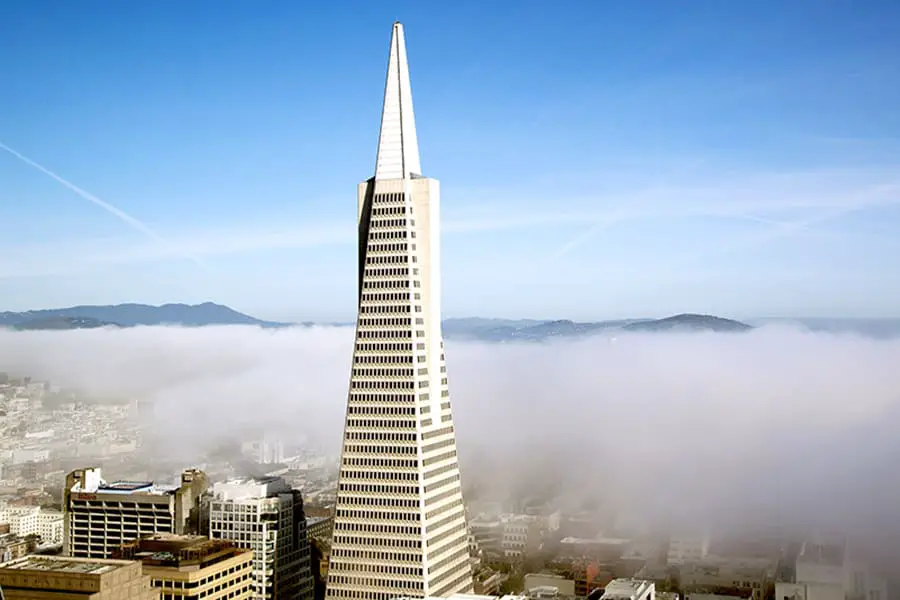
What do They Call the Fog in San Francisco and Why?
As we mentioned earlier, the fog in San Francisco has earned its own moniker – it goes by Karl. Naming the fog has helped to personify it, turning it from a dark and brooding presence to a sort of friendly, if damp, neighbor. But how on earth did Karl earn his name?
Let’s journey through time back to 2010. The Deepwater Horizon oil spill was in full swing, and British Petroleum’s lackluster cleanup efforts were making global headlines. A wag on Twitter decided to create a parody account, @BPGlobalPR (now suspended by Twitter), which posted snarky tweets from an imaginary BP public relations executive. A local San Franciscan saw this and ran with the idea to make a Twitter account for Karl.
But where did the name “Karl” actually come from? Legend has it that Karl’s name is a reference to the lonely and hungry giant from the movie Big Fish, who is not truly wicked – just misunderstood. Much like his namesake, Karl the Fog is not malicious or bad. He’s just the fog, rolling in through the Golden Gate, doing his thing.
Is the Poem “Fog” About San Francisco?
No, the poem “Fog” isn’t about San Francisco. Famed poet Carl Sandburg captured the essence of fog in his 1916 poem “Fog” – but as it happens, this poem is, in fact, about Chicago, not San Francisco. Nevertheless, the sentiment rings true for the Bay Area’s resident fog. Sandburg’s poem is short and eloquent:
The fog comes
on little cat feet.
It sits looking
over harbor and city
on silent haunches
and then moves on.
Burning Off the Fog
San Francisco may be known for its foggy conditions, and rightly so: the city does have its fair share of foggy weather. The natural meteorological and geographical conditions in the San Francisco area lend themselves to fog. Karl doesn’t disappoint, rolling off the ocean, flowing in through the Golden Gate to blanket the city on a regular basis.
Despite the fog, the California sunshine still gleams bright over the City by the Bay. And while there’s a good chance you’ll meet Karl on your trip to San Francisco, he’s not there all the time. If you do travel to San Francisco and get caught in the fog, don’t think of it as a mist opportunity. Embrace Karl, and experience the local weather in all its glory.


